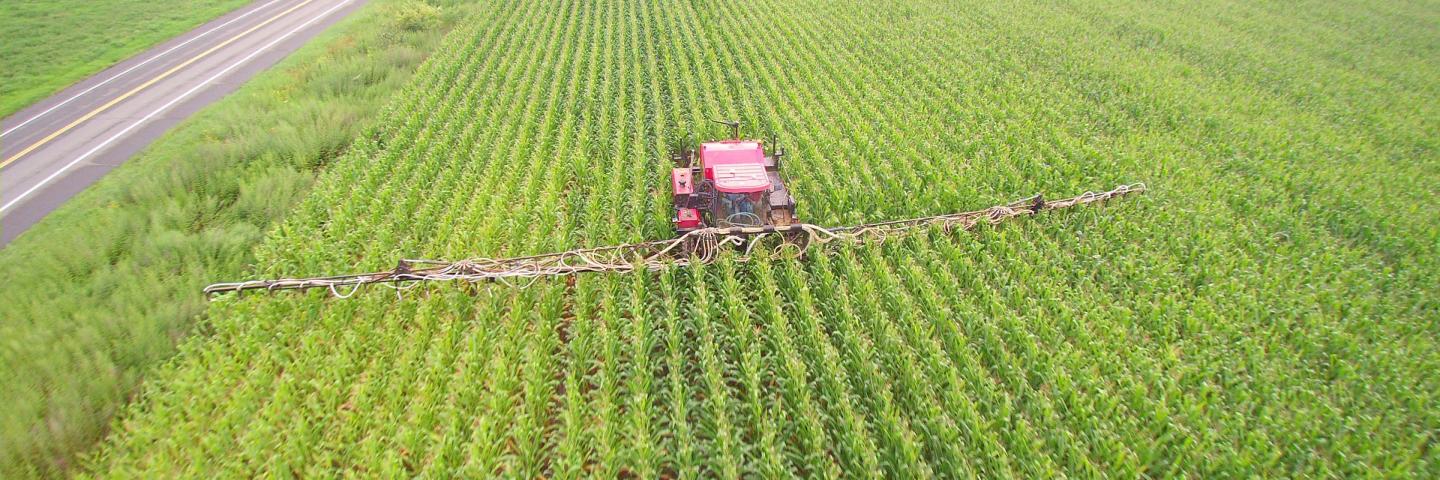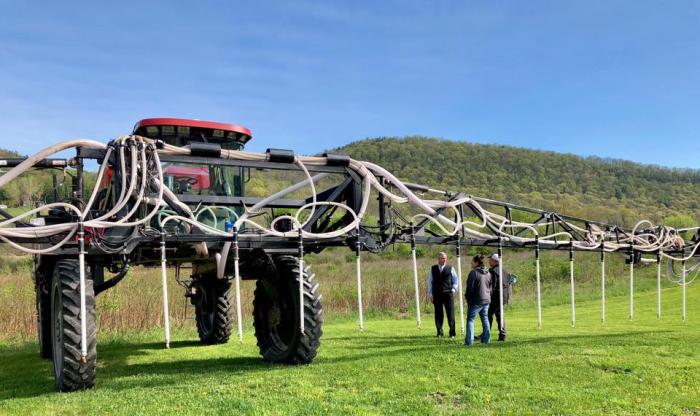
Conservation Innovation Grants Completed in Pennsylvania
The following Pennsylvania CIG agreements concluded in FY 2024:
American Farmland Trust, Inc.: Women for the Land: Helping Women Farmers and Landowners Advance Soil health in Pennsylvania. Through this agreement, an advisory group was established along with an adapted soil health curriculum and action plan for the women’s learning circles. In person trainings, virtual training, and farm field days were held. In addition, farmer profiles and a video were produced.
The following Pennsylvania CIG agreements concluded in FY 2023:
Pennsylvania Association for Sustainable Agriculture: Demonstrate that Alley Cropping Can Contribute to the Financial and Conservation Success of Arable Farm Operations. This project occurred because PASA had identified an interest in alley cropping and NRCS-Pennsylvania had not yet funded alley-cropping in their contracts. PASA’s consultant met with farmers at three farms to develop site-specific strategies. PASA then raised additional funding to install the systems at all three farms. Workshops and demonstration events promoted awareness and recommendations were provided to NRCS. They used their experience to secure other grants so they can continue this work and in January 2022, NRCS-Pennsylvania added Alley cropping as a fundable practice through the Environmental Quality Incentives Program (EQIP) and Climate Smart Agriculture and Forestry (CSAF) list.
TeamAg Inc.: Connecting Capital with PA farmers using Regenerative Farming Practices to Drawdown Carbon. Through this CIG, TeamAg explored how capital from companies that want to obtain carbon credits could be connected with from farms through regenerative agricultural practices done by Pennsylvania farms. The purpose of this grant was to improve farms’ economic and environmental performance through improved farm resilience and farm sustainability. The intent was to demonstrate that this innovative strategy will connect regenerative farm practices with social investors committed to the drawdown of atmospheric carbon. During the grant period, TeamAg completed 12 regenerative farm business plans. The University of Maryland Environmental Finance Center developed tools for economic and financial analysis that could be incorporated into the plans. These plans included an analysis of each farm’s regenerative farm systems accounting for soil health, soil carbon storage, greenhouse gas emissions, water quality, and systems biodiversity. Team Ag also provided regenerative ag services (planning and analysis) to approximately 45 other farms with grazing plans, soil health plans or regenerative farm plans. In additional TeamAg promoted regenerative agricultural services at many venues in during 2021-2023.
The Pennsylvania State University: Promoting Soil Health and Nutrient Conservation with Manure-injection and Cover Crop Interseeding. The project demonstrated cover crop interseeder that was developed at Penn State to no-till drill and establish cover crops between growing corn rows early in the season with the option to side-dress nitrogen at the same time. To encourage adoption of these two technologies, they provided financial cost-share to farms to adopt either of these practices along with technical assistance to enhance success. For each technology, they assisted farmers to implement the technology for one or two years and compare it to farming without the practice, in side-by-side farm scale field plots replicated multiple times on each farm. We compared injection of liquid-separate digested manure to surface application without incorporation on four no-till dairy farms over-six site years in spring prior to corn planting. Side-by-side field scale treatment comparison strips were replicated five or six times on each farm. Averaged across the six site-years, in the first 24 hours after liquid-separate digested manure was applied, injection reduced ammonia loss by 58% compared to surface broadcasting of digestate without incorporation. Pre-side dress nitrate tests and corn-stalk nitrate test samples at corn silage harvest indicated that most fields had more than sufficient nitrogen to meet corn yield goals with both application methods. Despite these test results, when liquid-separate digested manure was injected when corn silage yields were pooled across the six site-years, corn silage yield was significantly 3% greater when liquid-separate digested manure was injected than when surface broadcast. In addition, partial enterprise budget analyses we have completed for five of the six site-years to date indicate that net returns on injection was greater than surface broadcast. Over the three years of this project, we shared the results individually with the cooperating farmers and larger audiences through multiple outreach educational and scientific conferences.
The following Pennsylvania CIG agreements concluded in FY 2022.
Mid-Atlantic 4R Nutrient Stewardship Association:
Utilizing Nitrogen Modeling to Determined Soil Health Contributions to Nitrogen Fertility (funded in 2020) – This project studied nutrient management plan implementation in conjunction with soil health practices on 22 farms with the goal of demonstrating that nitrogen modeling tools should be considered as a Precision Ag Technology under CSP enhancement E590B to reduce risks of nutrient loss to surface water.
A comparison of the Granular Agronomy Nitrogen Service model (the crop model) to the mass balance nitrogen calculation identified a 10% improvement of nitrogen use efficiency on acres used the model compared to acres utilizing a mass balance calculation. A crop model can quantify soil nitrogen contributions from soil, manure, and fertilizer and can track nitrogen loss through leaching, immobilization, volatilization, and denitrification based on soil characteristics and user inputs. The process of working with the model platform provided an opportunity to talk with farmers about nutrient loss pathways on the farm. Challenges of both the currently accepted mass balance calculation and nitrogen modeling platforms include their inherent limits to reduce nitrogen loss, thereby improving water quality. Soil conditions, weather conditions, and other uncontrollable factors are ever-present that may increase the risk of inefficient nitrogen use and nitrogen loss. There are several key considerations for the use of models. 1) The accuracy of the information entered is key for the accuracy of the models’ outputs. 2) While models can’t predict weather, they can simulate what could likely happen. 3) Models are flexible with management because they simulate crop growth and conversion and movement of nutrients from various sources. 4) In addition, models simulate subprocesses including nitrogen loss pathways like nitrification, denitrification, leaching, mineralization, volatilization, and immobilization. 5) The reports from a model can foster discussion and potential changes to management.
Bradford County Conservation District:
Demonstrate that Alley Cropping Can Contribute to the Financial and Conservation Success of Arable Farm Operations. (funded in 2018) – Cover crops provide important conservation and production benefits when integrated in annual cropping systems. While cover cropping is increasing in popularity, adoption remains below 40% in PA. One challenge to cover cropping implementation includes poor establishment following late harvested crops. Because of limited time before winter to establish cover crops successfully, Penn State is researching ways to establish the cover crop into the standing cash crop, giving time for the cover crop to establish before cash grain harvest. The practice, known as interseeding, is not widely adopted. The aim of this CIG was to promote the adoption of interseeding cover crops in short growing season areas of Pennsylvania.

Bradford County Conservation District (BCCD) demonstrated cover crop interseeding technology in Pennsylvania’s northern counties. The shorter growing season and climate conditions in this part of the state make it difficult for farmers to establish cover crops following grain harvest. BCCD utilized a newly acquired interseeder to plant cover crops on over 4,000 acres on 67 farm sites in northern Pennsylvania and southern New York Counties. These demonstrations provided farmers in the area a first-hand look at the new machine and the results of the seedings. Results were mixed across the area due to weather variability; however, plans to continue interseeding in the area are moving forward for 2023.

